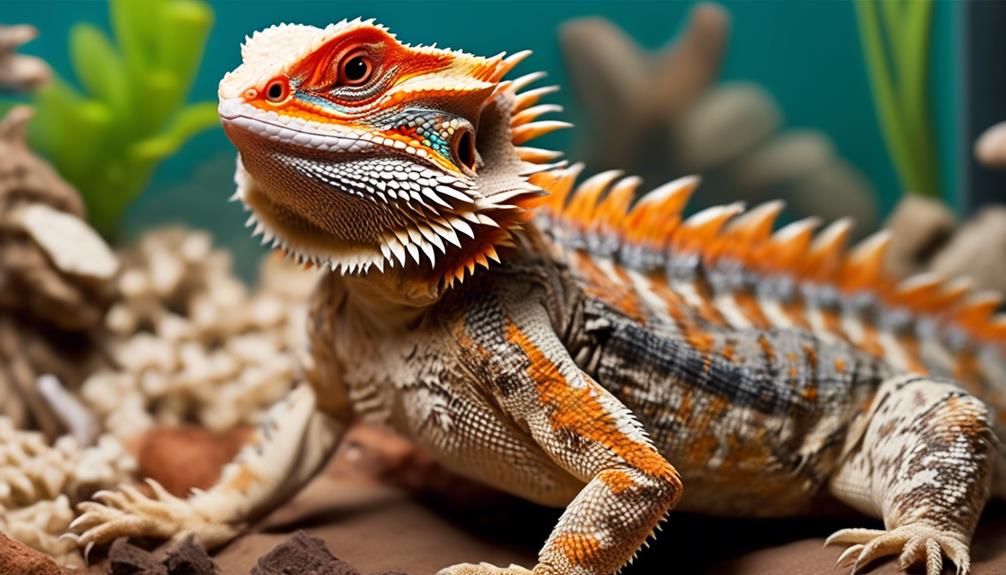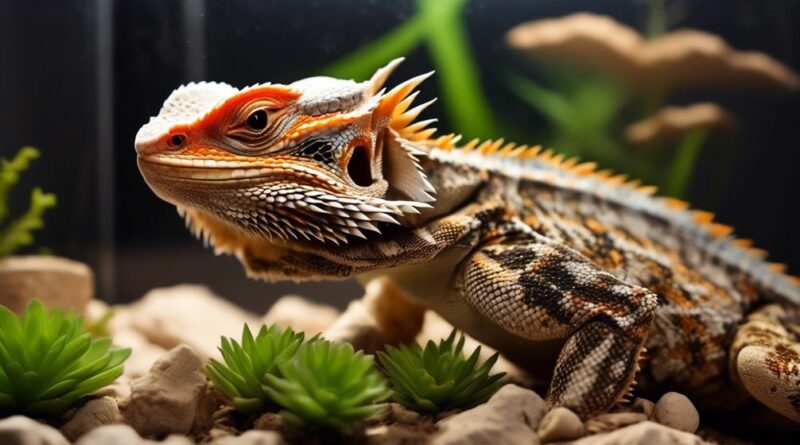Why Do Bearded Dragons Need Specific Habitat Requirements?
Do you ever wonder why bearded dragons need such specific habitat requirements?
It may seem like a lot to consider, but each element plays a crucial role in ensuring the health and well-being of your pet.
From temperature and lighting needs to substrate options and behavioral enrichment, every aspect of their habitat is carefully designed to mimic their natural environment and support their physical and psychological needs.
Understanding these requirements is key to creating a thriving environment for your bearded dragon, so let's explore the reasons behind each aspect and how it contributes to their overall happiness and longevity.
Temperature and Lighting Needs
To provide the ideal habitat for your bearded dragon, it requires specific temperature and lighting conditions. Proper heating is crucial for maintaining the overall temperature gradient within the enclosure. Bearded dragons are ectothermic, meaning they rely on external heat sources to regulate their body temperature. This can be achieved through the use of heat lamps or ceramic heat emitters, which should be placed at one end of the enclosure to create a basking spot. The basking spot should reach temperatures of around 95-105°F (35-40°C) to allow your dragon to thermoregulate effectively.
UVB lighting is equally important for your bearded dragon's overall health. These reptiles require exposure to UVB light in order to synthesize vitamin D3, which is essential for calcium metabolism and preventing metabolic bone disease. When selecting UVB lights, ensure they cover at least two-thirds of the enclosure and are replaced every 6-12 months to maintain their effectiveness.
In addition to heat and UVB lighting, it's important to establish appropriate light cycles to mimic natural sunlight. Bearded dragons require a consistent day and night cycle, typically 12-14 hours of daylight followed by 10-12 hours of darkness. This can be achieved using timers for both heat and UVB lighting.
Enclosure Size and Setup
Consider the size of your bearded dragon's enclosure and its setup to ensure a comfortable and stimulating environment for your pet. The enclosure size is crucial for the overall well-being of your bearded dragon. A general rule is to provide a minimum of 50-75 gallons for adult bearded dragons, allowing ample space for movement, basking, and exploring. Hatchlings and juveniles can start in a 20-gallon tank but will require larger enclosures as they grow.
When designing the enclosure, incorporate various elements to enrich your pet's habitat. This can include branches for climbing, rocks for basking, and hiding spots to create a diverse and engaging environment.
Enrichment activities are vital for your bearded dragon's mental and physical health. Adding different textures, such as reptile carpet, sand, and rocks, can stimulate their senses and provide opportunities for natural behaviors like digging. Additionally, providing a variety of plants, both live and artificial, can offer enrichment and a sense of security for your pet.
The design of the enclosure should prioritize safety and functionality. Ensure that all elements within the enclosure are securely placed to prevent any accidents. Furthermore, the setup should allow for easy access for cleaning and maintenance.
Substrate and Flooring Options
Ensure the substrate and flooring in your bearded dragon's enclosure provide a safe and comfortable surface for your pet to walk, rest, and explore.
When considering substrate options, it's important to prioritize materials that are hygienic and safe for your bearded dragon. Newspaper or paper towels make excellent substrate choices, as they're easy to clean and replace, reducing the risk of bacterial growth. Additionally, these options prevent the possibility of accidental ingestion, which can occur with loose substrates such as sand or gravel. If you prefer a more natural-looking substrate, reptile carpet or non-adhesive shelf liner are suitable alternatives. These options provide traction and can be easily cleaned in the event of accidents.
Avoid using loose substrates like sand, wood shavings, or walnut shell, as they can pose ingestion risks and lead to impaction if accidentally consumed. Furthermore, these substrates may harbor bacteria and parasites if not regularly cleaned and replaced. Remember that maintaining a hygienic flooring is crucial for your bearded dragon's health and well-being.
Ultimately, the key considerations for substrate and flooring options in your bearded dragon's enclosure are hygiene, safety, and ease of cleaning. By choosing a substrate that meets these criteria, you can provide a comfortable and secure environment for your pet to thrive.
Decor and Hideouts
Provide your bearded dragon with a variety of decor and hideouts to create a stimulating and secure environment within its enclosure. Naturalistic decorations such as rocks, branches, and logs not only add aesthetic appeal but also serve as hiding spots and climbing areas for your pet. Ensure that the basking areas are adorned with suitable decor that can withstand the heat and are easy to clean. Plant arrangements, such as artificial or live plants, can contribute to the overall enrichment of the enclosure, providing hiding spots and creating a more naturalistic environment.
Temperature gradients are crucial for the well-being of your bearded dragon. Decor and hideouts should be strategically placed to allow for the creation of these gradients. By positioning decor at varying distances from the heat source, your pet can self-regulate its body temperature by moving between warmer and cooler areas.
Additionally, lighting schedule plays a vital role in your bearded dragon's health and behavior. Decor should be placed in a way that allows for proper exposure to both UVB and basking light. Ensure that hideouts don't obstruct the light from reaching your pet, as this can affect their thermoregulation and overall well-being.
Feeding and Watering Stations
To ensure your bearded dragon's overall well-being, the feeding and watering stations within its habitat should be strategically positioned for easy access and maintenance. Proper positioning of these stations will help meet your bearded dragon's feeding schedule and hydration needs, as well as ensure it receives the necessary nutritional requirements from appropriate water sources.
It's essential to establish a feeding schedule for your bearded dragon to maintain its health. Offer a variety of insects, such as crickets, mealworms, and roaches, as well as leafy greens and vegetables. To ensure your pet stays hydrated, mist its habitat daily and provide a shallow water dish that's easily accessible.
When considering the nutritional requirements of your bearded dragon, it's crucial to provide appropriate water sources. Incorporate a water dish that's large enough for your pet to soak in, as bearded dragons may occasionally drink water by soaking themselves. Additionally, ensure the water is clean and changed regularly to prevent bacterial growth.
Remember to monitor your bearded dragon's feeding and drinking habits to make adjustments as needed. By carefully positioning feeding and watering stations in its habitat, you can help your bearded dragon meet its specific nutritional and hydration needs, contributing to its overall health and well-being.
Humidity and Ventilation Considerations
Maintaining the appropriate humidity levels in your bearded dragon's habitat is crucial for its respiratory health and overall well-being. Adequate ventilation is essential to control humidity and ensure the well-being of your pet. Proper ventilation helps to prevent the buildup of excess moisture in the habitat, which can lead to respiratory issues and skin problems for your bearded dragon.
When setting up the habitat, ensure that there's proper airflow to prevent stagnant, humid conditions. This can be achieved through the use of well-ventilated terrariums and ensuring that air can circulate freely within the enclosure. Additionally, placing the habitat in a well-ventilated area of your home can also contribute to maintaining optimal humidity levels.
Humidity control is crucial for your bearded dragon's health. In their natural habitat, bearded dragons are accustomed to arid environments with low humidity levels. In captivity, it's important to replicate these conditions to prevent health issues. High humidity can lead to respiratory infections, while low humidity can cause dehydration and shedding problems.
Cleaning and Maintenance Tips

When cleaning and maintaining your bearded dragon's habitat, it's essential to regularly remove uneaten food, feces, and shed skin to keep the enclosure clean and hygienic. This not only ensures a healthy environment for your pet but also prevents any potential health issues from arising.
To effectively maintain your bearded dragon's habitat, consider the following tips:
- Waste Disposal: Promptly remove any uneaten food, feces, and shed skin from the enclosure. This will help prevent the buildup of bacteria and parasites, reducing the risk of infections for your bearded dragon.
- Odor Control: Regularly clean and replace the substrate to minimize odor. Be sure to use reptile-safe cleaning products when disinfecting the habitat to prevent any harmful residues that could be toxic to your pet.
- Regular Cleaning Schedule: Establish a routine for cleaning and maintenance. This could include daily spot cleaning, weekly substrate changes, and monthly deep cleaning of the entire habitat. Consistency is key to maintaining a healthy and hygienic environment for your bearded dragon.
Behavioral Enrichment and Handling Suggestions
Keeping your bearded dragon engaged and mentally stimulated is essential for their overall well-being and health. Environmental stimulation is crucial for their mental engagement.
Providing a variety of climbing structures, basking spots, and hiding places in their habitat can keep them physically active and mentally stimulated. Consider adding branches, rocks, and even artificial plants to create a stimulating environment. Rearranging the habitat occasionally can also provide mental stimulation as it creates a sense of novelty for your bearded dragon.
In addition to environmental stimulation, social interaction and handling techniques are vital for the well-being of your bearded dragon. While they may not seek out social interaction in the same way as some other pets, regular, gentle handling can help them get accustomed to human interaction.
When handling your bearded dragon, it's important to support their body properly and avoid sudden movements to prevent stress. Start with short handling sessions and gradually increase the duration as they become more comfortable.
Furthermore, incorporating interactive feeding techniques such as using food puzzles or hiding food around the habitat can provide mental stimulation and mimic their natural foraging instincts. This not only keeps them mentally engaged but also encourages physical activity.
Frequently Asked Questions
Can Bearded Dragons Live Together in the Same Enclosure?
Yes, bearded dragons can live together, but it's important to consider compatibility issues and behavior modification. Territorial disputes and social dynamics may arise, so monitor their interactions closely and be prepared to separate them if necessary.
Do Bearded Dragons Need a Specific Type of Basking Spot or Can Any Heat Source Work?
For your bearded dragon, it's crucial to set up a proper basking spot. Not just any heat source will work. Be sure to provide a suitable heat source, as they need specific temperatures to thrive.
Are There Any Specific Plants That Should Be Avoided in a Bearded Dragon Enclosure?
When setting up your bearded dragon's enclosure, it's crucial to avoid toxic plants like aloe, ivy, and daffodils. Opt for safe options such as hibiscus, rosemary, and spider plants for a natural and comfortable habitat.
How Often Should Bearded Dragons Be Handled to Ensure They Are Properly Socialized?
To ensure bearded dragons are properly socialized, handle them regularly with proper techniques. Aim for short sessions a few times a week, gradually increasing the duration. Respect their cues and avoid overhandling to prevent stress.
Can Bearded Dragons Eat Wild Insects Found in the Backyard, or Should They Stick to Store-Bought Feeder Insects?
You should avoid feeding your bearded dragon wild insects from the backyard. Stick to store-bought feeder insects to ensure their safety. Wild insects can carry pesticides, parasites, and diseases that can harm your pet.
Conclusion
So, remember to provide your bearded dragon with the right habitat setup to keep them healthy and happy.
By meeting their specific temperature, lighting, and space needs, as well as providing proper substrate and decor, you can create an environment that supports their natural behaviors and well-being.
Don't forget to regularly clean and maintain their habitat, offer behavioral enrichment, and handle them gently to ensure they thrive in their home.
